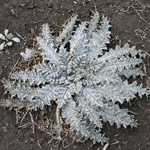Stemless thistle
Common name:
- Stemless thistle
Scientific name:
- Onopordum acaulon L.
Plant status
Catchment management authority boundaries
Regionally prohibited in the Port Phillip and Western Port catchments.
Regionally controlled in the East Gippsland and North East catchments.
Restricted in the Mallee, West Gippsland, North Central Glenelg Hopkins, Corangamite, Wimmera and Goulburn Broken catchments.
Plant biology
Appearance
Herbaceous plant — Forb (flowering herbaceous plant — not a grass)
Description
Stemless thistle is a prostrate annual or biennial herb.
Stems
Absent.
Leaves
Leaves of stemless thistle are whitish and very woolly, growing to 40cm long. Leaf lobes are deep and undulate and leaves have many spines on the margins. Leaves have short stalks and are arranged in a large rosette.
Flowers
The flowers of stemless thistle are white to purple florets with globular heads. They are sessile (without stalks), grow to 6cm in diameter and are clustered in the centre of the rosette with each head surrounded by numerous sharply spined bracts.
Fruit
No fruit.
Seeds
Seeds of stemless thistle are brown or grey, 4 to 5mm long, quadrangular, pitted and ridged lengthwise. It has a pappus of cream-coloured barbed hairs 2 to 2.5cm long.
Growth and lifecycle
Method of reproduction and dispersal
With a large feathery pappus, the seeds of the stemless thistle are well adapted for wind dispersal. In Victoria, aided by prevailing winds, seeds have been dispersed over 200m.
Dispersal also occurs when seeds contaminate agricultural produce, vehicles and animals. However, this dispersal method is of minor importance compared with wind dispersal.
Seed is also spread via birds in:
- hay
- silage
- chaff
- commercial seed
- water.
Seedbank propagule persistence
Stemless thistle can reproduce as either an annual or biennial. It produces 8 flower heads per plant with 150 seeds per head resulting in 1200 seeds per plant.
Stemless thistle seed can survive in the soil for several years making eradication difficult. Plants cut below the surface with cultivation equipment may re-sprout from root fragments, commonly producing multiple crowns.
Preferred habitat
Stemless thistle prefers warm-temperate regions typically in areas receiving less than 450mm of annual rainfall — more prevalent on sandy soils but also occasionally appears on heavier calcareous soils. It is drought tolerant and found mainly in pastures, roadsides and neglected areas.
Distribution
Stemless thistle invades Mallee shrubland, lowland grassland and grassy woodland.
Growth calendar
The icons on the following table represent the times of year for flowering, seeding, germination, the dormancy period of stemless thistle and also the optimum time for treatment. th> Dormancy
| Jan | Feb | Mar | Apr | May | Jun | Jul | Aug | Sep | Oct | Nov | Dec | |
|---|---|---|---|---|---|---|---|---|---|---|---|---|
| Flowering | ||||||||||||
| Seeding | ||||||||||||
| Germination | ||||||||||||
| Dormancy | ||||||||||||
| Treatment |
Impact
Impact on ecosystems and waterways
Stemless thistle is commonly found in pastures, and on roadsides, channel banks and fallow ground. In Victoria, the weed is widespread and occurs in medium to large populations. It also has a major effect on native ground covers and grasses.
Agricultural and economic impacts
Stemless thistle is rarely eaten by stock therefore reducing the carrying capacity of heavily infested paddocks. However, when stock have been forced to eat the plant, cases of impaction and suspected liver damage have occurred.
Stemless thistle is not known to affect the quality of cropping produce and harvesting costs. Seeds survive in the soil for several years making eradication difficult. It has the potential to reduce land values in agricultural areas.
Social value and health impacts
The spiny nature of the stemless thistle may restrict some recreational activities. The weed's sharp spines may also cause minor injuries to humans with spines being present for much of the year.
Management
Prescribed measures for the control of noxious weeds:
- application of a registered herbicide
- physical removal.
Read about prescribed measures for the control of noxious weeds.
Other management techniques
Changes in land use practices and spread prevention may also support stemless thistle management after implementing the prescribed measures.